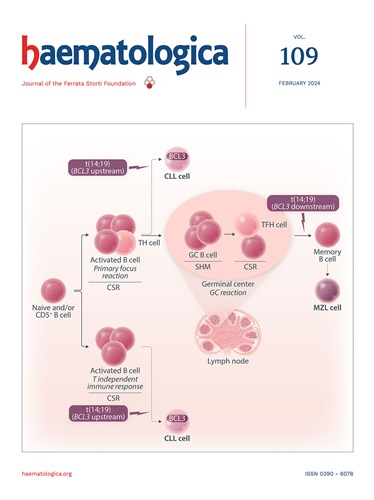Real-world validation study of the LSC17 score for risk prediction in patients with newly diagnosed acute myeloid leukemia.
IF 7.9
1区 医学
Q1 HEMATOLOGY
引用次数: 0
Abstract
Acute myeloid leukemia (AML) patients exhibit diverse molecular and cytogenetic changes with heterogeneous outcomes. The functionally-derived LSC17 gene expression score has demonstrated strong prognostic significance in retrospective analyses of adult and pediatric AML cohorts, where above-median scores are associated with worse outcomes compared to below-median scores in intensively-treated patients. Here we used a laboratory-developed clinically-validated NanoStringbased LSC17 assay to test the prognostic value of the LSC17 score in a prospective multicentre study of 276 newly-diagnosed AML patients. Each patient's score was classified as high or low by comparison to a previously-established reference score. In the entire cohort, a high LSC17 score was associated with poor risk features, including advanced age and unfavorable genetic mutations. In the subset of 190 patients treated intensively, a high LSC17 score was associated with lower remission rates (63% vs 94% after induction, P.LSC17评分用于新诊断急性髓性白血病患者风险预测的真实世界验证研究
急性髓性白血病(AML)患者表现出不同的分子和细胞遗传学变化和不同的结果。功能来源的LSC17基因表达评分在成人和儿童AML队列的回顾性分析中显示出很强的预后意义,在强化治疗的患者中,高于中位数的评分与低于中位数的评分相比,预后更差。在此,我们使用实验室开发的临床验证的基于nanostring的LSC17检测方法,在276例新诊断的AML患者的前瞻性多中心研究中测试LSC17评分的预后价值。通过与先前建立的参考评分进行比较,每个患者的评分被分为高或低。在整个队列中,高LSC17评分与较差的风险特征相关,包括高龄和不利的基因突变。在接受强化治疗的190例患者中,高LSC17评分与较低的缓解率相关(诱导后为63% vs 94%, P。
本文章由计算机程序翻译,如有差异,请以英文原文为准。
求助全文
约1分钟内获得全文
求助全文
来源期刊

Haematologica
医学-血液学
CiteScore
14.10
自引率
2.00%
发文量
349
审稿时长
3-6 weeks
期刊介绍:
Haematologica is a journal that publishes articles within the broad field of hematology. It reports on novel findings in basic, clinical, and translational research.
Scope:
The scope of the journal includes reporting novel research results that:
Have a significant impact on understanding normal hematology or the development of hematological diseases.
Are likely to bring important changes to the diagnosis or treatment of hematological diseases.
 求助内容:
求助内容: 应助结果提醒方式:
应助结果提醒方式:


